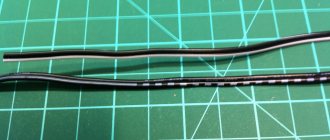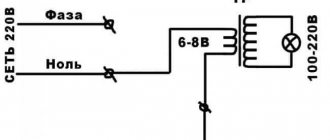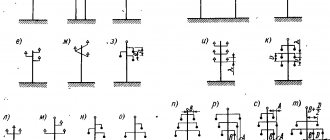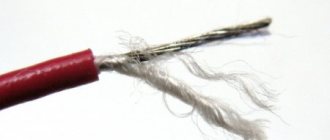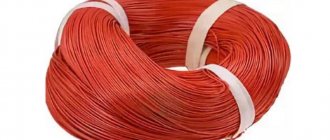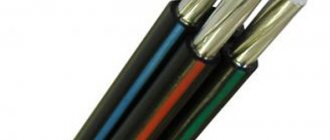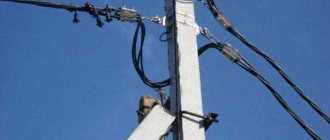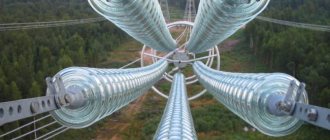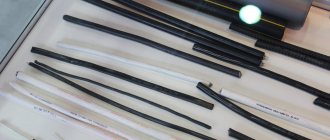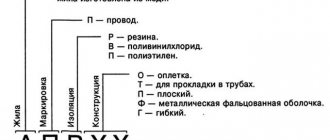Self-supporting insulated wire
In groups
Insulated wires - Insulated wires for overhead lines - SIP produced by JSC Kamkabel
on RusCable.Ru: - all brands of Kamsky Cable LLC - page of Kamsky Cable LLC
General information from RusCable.Ru
according to the SIP-2 brand
SIP-2 from other manufacturers
Saranskkabel
Tomskkabel
"MOSKABELMET"
"Cable
TU 16.K71-268-98
Application area
Self-supporting insulated wires (SIP) are intended for use in overhead power lines (power lines) suspended on supports or facades of buildings and structures.
Climatic modification - UHL, placement categories - 1, 2 and 3, in atmospheres of type II and III according to GOST 15150-69.
As a result of generalizing domestic experience in the construction and operation in a number of regions of the country of overhead power lines with a voltage of 0.38 kV with self-supporting insulated wires, the technical and economic advantages of these lines were revealed in comparison with overhead power lines of 0.38 kV with uninsulated wires.
Based on the positive experience of using self-supporting insulated wires in power systems, the RAO UES of Russia directive document No. OB-5145 dated June 26, 2000 “On the use of self-supporting insulated wires in construction and reconstruction” was issued.
Peculiarities
SIP is a self-supporting insulated wire, used for power supply in power networks. The SIP electric cable is used in a network with voltage: SIP-1, SIP-2, SIP-4 and SIP-5 are designed for a rated voltage of up to 1 kV, SIP-3 up to 35 kV.
Most SIP wires produced in Russia are color-coded in accordance with the PUE (Electrical Installation Rules) and the new GOST 50462-2009. The insulation of phase conductors and the supporting neutral conductor is made of thermoplastic polyethylene or silanol-cross-linked (light-stabilized) polyethylene, which can withstand temperatures of about 80-90°C for a long time
The technical characteristics of the SIP cable are regulated by GOST R 52373-2005 / GOST 31946-2012 / TU 16-705.500-2006, according to which self-supporting insulated wires include products for overhead lines with voltages up to 0.6/1 kV inclusive, and - protected wires, products for the same lines, but with voltage up to 10 kV; from 10 to 20 kV; 20 kV and 35 kV. There are different types of SIP wire. Most often, SIP type cables are classified by cross-section: 4x16, 2x16, 4x50, 4x25, 4x35, etc. Also, the brand of wire is divided according to the type of core insulation and technical characteristics:
- SIPT-1, also known as SIP-1 - except for the zero core, all the rest are insulated with special polyethylene. SIP-1 is produced for 380 V networks. This is a four-wire cable made of aluminum or aluminum alloy, three cores are covered with light-resistant polyethylene, resistant to ultraviolet radiation, and the fourth without braid with a steel core acts as a carrier and neutral.
- SIPT-2 and SIPT-1A - all threads are isolated;
- SIP-2 - all cores (except for the zero wire) are insulated with cross-linked polyethylene;
- SIP-2A - all conductors, including neutral, are covered with a layer of cross-linked polyethylene;
- SIP-3 - a wire consisting of one conductive core, made of a dense alloy or steel-aluminum wire structure, the insulating layer is made of cross-linked light-stabilized polyethylene. SIP-3 is used for transmitting electrical energy with voltages up to 20 kV;
- SIP-4 - all four cores are insulated with thermoplastic polyethylene, but there is no separate load-bearing core. When laying and tensioning the line, all conductors carry the load, i.e. fastening is carried out immediately for all conductors;
- SIP-5 - does not have a separate load-bearing core, the rest are covered with a sheath of cross-linked (light-stabilized) polyethylene, the number of cores is two or more. They are used mainly in enterprises or for extending electrical networks in the city or between populated areas. It consists of insulated strands coated with polyethylene, where each strand is wrapped in a separate sheath. Types of wire SIP-4 and SIP-5 do not have a supporting zero core and can consist of two or more threads (most often 2 or 3).
Advantages of SIP
- With equal capital investments, power lines with self-supporting insulated wires require lower operating costs;
- Reducing the width of clearings to be cut down during the construction of power lines in forest areas;
- Possibility of joint suspension on supports of wires with different voltage levels and with telephone lines;
- The possibility of installing power lines along the facades of buildings, which can eliminate the installation of some of the supports that clutter the sidewalks, it is possible to lay a completely or partially hidden network, making it easier to connect branches to buildings;
- Reducing safe distances to buildings and other engineering structures (electrical, telephone, overhead lines);
- Height above ground level - 4 meters, for bare wires - 6 meters;
- The possibility of a short circuit between phase wires or to ground is excluded;
- Eliminating the risk of fires if wires fall to the ground;
- High service safety - no risk of injury when touching live phase wires;
- Less weight and longer duration of snow sticking, increased reliability in areas of intense ice formation, reduction of ice and wind loads on supports;
- Reduced voltage drop due to low reactance;
- Reducing the volume of emergency recovery work;
- Ease of repair, especially when working under voltage;
- Reducing the likelihood of electricity theft and destruction of power lines;
- Safety of work near power lines.
At the customer's request, SIP-2 wire can be supplied with additional insulated conductors with a cross-section of 16 or 25 mm2 for connecting lighting circuits.
Characteristics of SIP wire
Well, we have chosen SIP wires, brands and cross-sections that meet our requirements. But, as in any other case, it is also important for us to know the characteristics of this type of conductor. Conventionally, they can be divided into two types - electrical and mechanical.
Electrical characteristics
Let's start our conversation with electrical characteristics, which are decisive for any conductor. These include internal resistance, insulation resistance and requirements for the conductor during its high-voltage tests.
Permissible current loads of SIP wires
- The electrical resistance of each individual core depends on the cross-section of the wire, the material of manufacture and temperature indicators. After all, the lower the temperature of the conductor, the lower its resistance. And for us it is extremely important to have as little conductor resistance as possible.
Standardized resistance values of SIP wire cores
- For SIP brand wires, the maximum electrical resistance of each individual core is strictly standardized. All these data are summarized in Table 3 of GOST 31946 - 2012. In it we see, for example, that a wire with a cross-section of 25 mm2 should have a resistance of no higher than 1.38 Ohms per 1 km of its length. And a wire with a cross-section of 120 mm2 has a resistance of no more than 0.288 Ohm.
Note! All these requirements are given for a conductor temperature of 20⁰C. If it differs from this indicator, then special correction factors should be applied.
- Now a few words about the specific volumetric resistance of insulation. For a SIP wire it must be at least 1×1012 Ohm×cm.
High voltage testing of SIP wire
- But as for high-voltage tests, everything is a little more complicated. The fact is that for SIP-1, 2 and 4 the same standards are established, and for the SIP-3 brand others. This is related to the voltage class.
- So, if you decide to test it yourself, then the wire up to 1 kV should be kept in water for 10 minutes. After this, it must withstand a voltage of 4 kV for at least 5 minutes. In addition, the self-supporting wire must withstand a pulse voltage of 20 kV.
- As for SIP-3 brand products, it all depends on the voltage class for which it is designed. Thus, a wire with a rated voltage of 20 kV after exposure to water for 10 minutes must withstand a voltage of 6 kV for 5 minutes. And the option for a rated voltage of 35 kV, under the same conditions, must withstand 10 kV.
Summary table of SIP wire tests
- Someone may suspect us of making a mistake. How is it so: the rated voltage of the wire is 20 kV, but it is tested with a voltage of 6 kV? But this is due to the fact that this type of insulation is not the main one - that is, it is not required to withstand the rated voltage for a long time. Its task is to reduce the likelihood, and not completely eliminate, any possible types of short circuits as in the video.
- That is why there is also such an indicator as breakdown voltage, which SIP-3 wire is also tested for. After keeping the wire in water for an hour, the breakdown voltage must be at least 24 kV for wires rated at 20 kV, and at least 40 kV for wires rated at 35 kV.
Mechanical characteristics
And finally, let’s take a quick look at the mechanical characteristics of the SIP wire. There are a lot of these parameters, ranging from permissible temperatures to soot content, or resistance to insulation penetration at a temperature of 90⁰C. We will focus only on the most relevant for us.
- First of all, this is the breaking force that the wire must withstand. It is clear that this indicator directly depends on the cross-section of the wire.
For example, a wire with a cross-section of 25 mm2 must withstand at least 7.4 kN, and a wire with a cross-section of 120 mm2 must withstand at least 35.2 kN. If it is more convenient for you to see this value in kgf, then 1 kgf = 10N.
Breaking force of SIP wire
- Separate requirements are also imposed on wire insulation. It must fit tightly to it, and therefore the force required to shift the insulation is strictly standardized.
Requirements for the tightness of the insulation to the wire
- A separate issue is temperature effects. Temperatures ranging from +50⁰С to -40⁰С are considered normal for operation. But it must also withstand temperatures up to +70⁰С or -60⁰С.
- In addition, it must withstand exposure to solar radiation, rain and other atmospheric factors. As well as cyclical exposure to different temperatures.
- There are other parameters that the SIP wire must meet. All of them are summarized in the photo below.
Mechanical characteristics of SIP wires
Specifications
| Parameter | Meaning |
| Rated alternating voltage frequency 50 Hz, kV | 1,0 |
| Operating temperature of the core, no more than °C | 90 |
| Core temperature in overload mode for 8 hours, no more than °C | +130 |
| Short circuit temperature for 5 seconds, no more than °C | +250 |
| Ambient temperature, min./max., °C | -50/+50 |
| Installation at a temperature not lower than °C | -20 |
| Service life, years | 25 |
| Warranty period, years | 3 |
Resistance of current-carrying conductors, no more, Ohm/km
| cross section, sq.mm | phase | carriers |
| 16 | 1,91 | — |
| 25 | 1,20 | 1,38 |
| 35 | 0,868 | 0,986 |
| 50 | 0,641 | 0,720 |
| 54,6 | — | 0,630 |
| 70 | 0,443 | 0,493 |
| 95 | 0,320 | 0,363 |
| 120 | 0,253 | 0,288 |
| 150 | — | 0,236 |
Tensile strength of load-bearing cores, not less, kN
| cross section, sq.mm | carriers |
| 25 | 7,4 |
| 35 | 10,3 |
| 50 | 14,2 |
| 54,6 | 16,6 |
| 70 | 20,6 |
| 95 | 27,9 |
| 120 | 35,2 |
| 150 | 43,4 |
Types of wire
By design, the following types of SIP cable are distinguished:
- SIP 1. Conductor products of this brand consist of aluminum phase conductors, insulated with ultraviolet-resistant polyethylene, and an uninsulated neutral wire. To increase strength (the neutral conductor also performs a load-bearing function), the neutral wire of this brand has a steel core. If the marking of such a cable has the letter A, then the neutral conductor has an insulated core. The scope of application of this brand of wire is low-voltage lines with voltages up to 1000 V.
- SIP 2. This wire or cable is used in power and lighting lines up to 1 kV. This wire consists of 4 cores made of aluminum in polyethylene insulation. The neutral conductor, which performs the load-bearing function, is reinforced with a steel core.
- SIP 3. Leading products of this brand consist of one steel-aluminum conductor insulated with polyethylene. These products are used for constructing high-voltage networks. The rated voltage of these wires is 10 kV... 35 kV.
- SIP 4. This wire consists of 2 or 4 insulated conductors. The difference between SIP 2 and SIP 4 lies in the design of the cores. SIP 4 does not have a load-bearing core. This wire is used in overhead lines up to 1000 V in power and lighting electrical networks.
- SIP 5. For overhead power transmission lines with voltages of 10, 15, 20 kV and 35 kV with a nominal frequency of 50 Hz in the air atmosphere, including on the coasts of seas, salt lakes, etc. The wire structure consists of aluminum conductors; there is no separate supporting conductor.
Structural and electrical parameters
| Number and cross-section of cores, pcs. x sq.mm | Estimated weight, kg/km | Diameter, mm | Permissible current load, A | One-second short circuit current, kA | |
| with aluminum alloy core | with aluminum core, reinforced with steel wire | ||||
| 1x16 + 1x25 | 135,4 | 156,7 | 15,0 | 105 | 1,5 |
| 2x16 | — | — | 14,0 | 100 | 1,5 |
| 2x25 | — | — | 17,0 | 130 | 2,3 |
| 3x16 + 1x25 | 267,4 | 288,6 | 22,0 | 100 | 1,5 |
| 4x16 + 1x25 | 333,3 | 354,6 | 26,0 | 100 | 1,5 |
| 4x16 | — | — | 22,0 | 100 | 1,5 |
| 3x25 + 1x35 | 393,2 | 426,4 | 26,0 | 130 | 2,3 |
| 4x25 + 1x35 | 491,7 | 525,0 | 26,0 | 130 | 2,3 |
| 4x25 | — | — | 26,0 | 130 | 3,2 |
| 3x25 + 1x54.6 | — | — | 26,6 | 130 | 2,3 |
| 3x35 + 1x50 | 528,7 | 571,8 | 30 | 160 | 3,2 |
| 3x35 + 1x54.6 | — | — | 28,4 | 160 | 3,2 |
| 3x50 + 1x50 | 687,5 | 730,6 | 32 | 195 | 4,6 |
| 3x50 + 1x54.6 | — | — | 32,8 | 195 | 4,6 |
| 3x50 + 1x70 | 743,1 | 805,7 | 35,0 | 195 | 4,6 |
| 3x70 + 1x54.6 | — | — | 36 | 240 | 6,5 |
| 3x70 + 1x70 | 929,0 | 991,6 | 37,0 | 240 | 6,5 |
| 3x70 + 1x95 | 998,4 | 1085,1 | 41,0 | 240 | 6,5 |
| 3x95 + 1x70 | 1186,0 | 1248,6 | 41 | 300 | 8,8 |
| 3x95 + 1x95 | 1255,4 | 1342,1 | 45,0 | 300 | 8,8 |
| 3x120 + 1x95 | 1481,6 | 1568,3 | 47,0 | 340 | 7,2 |
